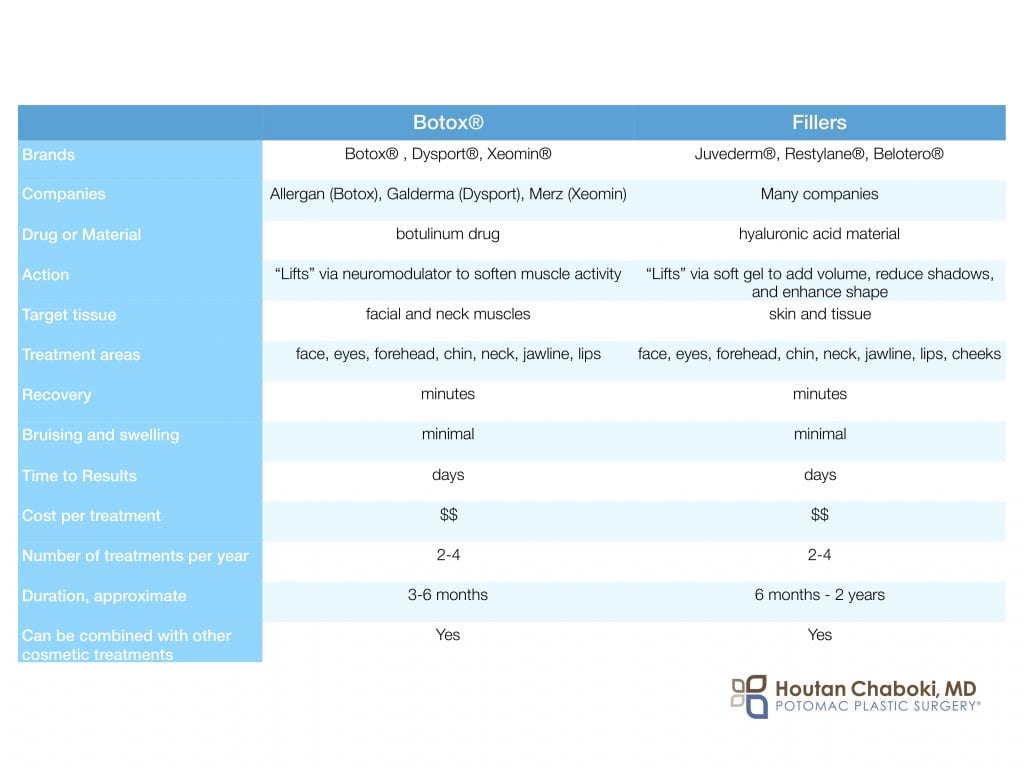
Nonsurgical treatments with Botox (and similar drugs) along with facial fillers are popular treatments as part of a liquid facelift. Facial plastic surgeons, such as Dr. Chaboki, offer these office treatments for patients who want to enhance their appearance.
Nonsurgical treatments continue an upward trend, even in plastic surgery offices. Patients enjoy the reduced downtime as compared to surgery, even if results might be less dramatic. Injections are the most common nonsurgical treatment with Botox and fillers, but patients are sometimes confused between these two office treatments. Plastic surgery and dermatology offices may group these treatments together as injectables or liquid lift.
Neuromodulator – Botox, Dysport, and Xeomin
Botox is one option in a group of treatments of neuromodulators or wrinkle relaxers. Dysport and Xeomin are alternatives to Botox that work in a similar fashion.
After a numbing cream, neuromodulators are given by a small needle to temporarily relax muscle. Results develop gradually over several days after treatment and then fade gradually at the end of its course. Effects may last 3-6 months, depending on multiple factors.
Treatment areas and effects continue to increase with time. Previously, neuromodulators such as Botox was only considered to treat forehead wrinkles. Now these neuromodulators can treat many wrinkles throughout the face and neck, lift the brow and neck, reduce pain, and shape the face in certain patients.
Read more about Botox treatments in our blog.
Fillers – Juvederm, Restylane, Belotero
Fillers are soft gels injected into tissues that can have a variety of effects. Fillers vary by their thickness, consistency, and reaction to surrounding tissue. Thinner fillers are better for superficial wrinkles of the skin and blend with tissue more readily. Thicker fillers are better to enhance deep shadows and augment broader areas.
Fillers injections can be layered and don’t need to be all done at once. Some patients prefer an active phase where they build up filler gels quickly over time to achieve a desired result, then come to the office less frequently for touch-up and maintenance treatments.
Filler treatments are performed with a small needle or blunt cannula. Results are immediate, but may needle some time to integrate with the tissue. Bruising and swelling tend to be higher with fillers as compared to neuromodulators. Filler results may last 6 months to 2 years depending on multiple factors.
Read more about filler injections in our blog.
Best nonsurgical injection
There isn’t a “best” nonsurgical treatment for all patients. Areas such as the forehead are primarily treated with neuromodulators to relax wrinkles, while areas such as under eye dark circles are better treated with fillers to reduce shadows. Top plastic surgeons offer a variety of options, surgical and nonsurgical, for their patients. One can consider plastic surgeons as “artists” who use these tools to sculpt and to enhance one’s appearance. With professional guidance, patients can then choose the best option appropriate for them.
In addition, some may not be candidates for a liquid facelift with either neuromodulators or fillers to achieve their desired results. Those who seek a permanent change or more dramatic change may be better candidates for surgery. We’ve previously reviewed excess skin and skin laxity as reasons that surgery may be required. Read more about skin laxity in facelift surgery.
Contact the office for a consultation with Dr. Chaboki, a Washington DC facial plastic surgeon, who specializes in both surgical and nonsurgical treatments.

Leave a Reply